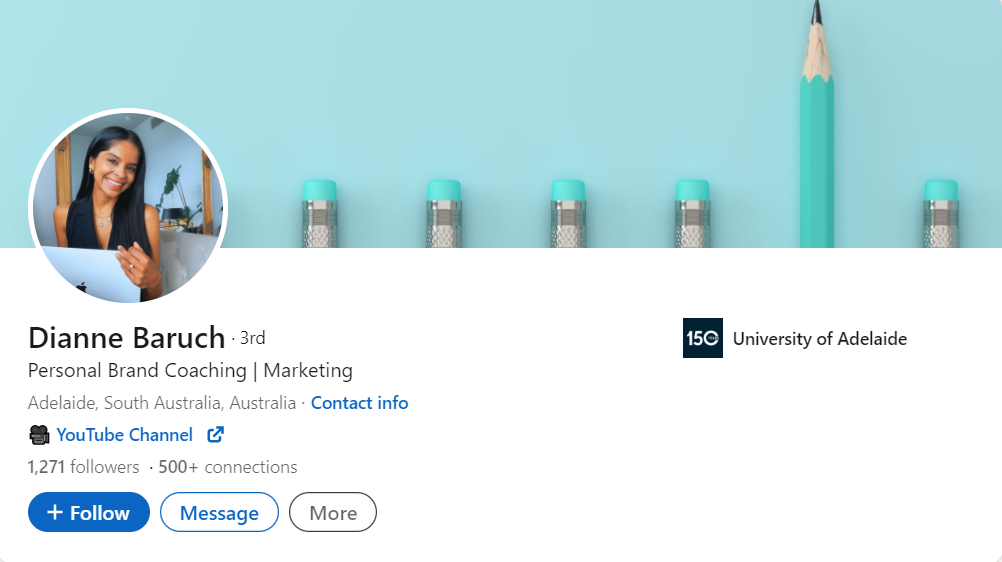As a professional, you cannot deny the importance of a strong online presence. LinkedIn serves as a digital bridge between potential employers or recruiters and job seekers, regardless of industry. However, simply having a non-click-worthy profile on LinkedIn isn’t enough. To stand out from the crowd and get noticed by the right people, you need to optimize your profile for LinkedIn SEO (Search Engine Optimization).
Quick Snapshot of the Whole LinkedIn SEO Optimization
Here are the 8 LinkedIn SEO tips discussed in the blog post put forward by renowned LinkedIn specialist and personal branding coach, Dianne Baruch:

- Determine your LinkedIn SEO keywords
- Customize your LinkedIn URL
- SEO optimize your LinkedIn headline
- SEO optimize your LinkedIn about me section
- Write your work history with your LinkedIn SEO in mind
- Add your LinkedIn skills with your LinkedIn SEO strategy in mind
- Optimize your location (if applicable)
- Create content consistently
What is LinkedIn SEO and Why is it Important?
Just like Google Search, LinkedIn uses an algorithm to rank profiles in search results. When someone searches for keywords related to your industry, skills, or experience, LinkedIn SEO optimization ensures your profile appears at the top of the search results. This increases your visibility to potential opportunities and makes it easier for them to find you.
Here’s why LinkedIn SEO is crucial for your professional success:
- Increased Visibility: A well-optimized profile ranks higher in search results, leading to more profile views and connections.
- Targeted Audience: By incorporating relevant keywords, you attract the right people who are searching for professionals with your skillset.
- Enhanced Credibility: A well-crafted profile showcases your expertise and accomplishments, projecting a professional image to potential employers.
- Improved Networking Opportunities: Higher visibility leads to more connection requests and the chance to build valuable relationships.
The 8 Powerful Strategies for LinkedIn SEO Optimization


Now that you understand the importance of LinkedIn SEO, let’s delve into the actionable strategies you can implement to optimize your profile and get discovered:
-
Identify Your LinkedIn SEO Keywords
The first step is to determine the keywords that potential employers or recruiters would use to search for someone in your field. Consider these factors when choosing your keywords:
- Industry Keywords: Include relevant terms specific to your industry (e.g., marketing automation, software development, financial analysis).
- Job Title Keywords: Target keywords that reflect your desired job title (e.g., social media manager, data scientist, project manager).
- Skill Keywords: Identify keywords that showcase your key skills and expertise (e.g., content marketing, Python programming, financial modeling).
2. Craft a Compelling LinkedIn Headline with SEO in Mind
Your headline is one of the first things people see when they come across your profile, so it needs to be impactful and informative. Here’s how to optimize your headline for SEO:


Here is Dianne’s tutorial for LinkedIn SEO optimization tips:
- Move Beyond the Job Title: Don’t just list your current job title and company name. This is a missed opportunity to showcase your unique value proposition.
- Target Your Keywords: Integrate your target keywords into your headline, but prioritize clarity over keyword stuffing.
- Quantify Your Achievements (Optional): If relevant to your field, consider including quantifiable achievements or results to grab attention (e.g., “Social Media Manager | Increased website traffic by 20%”).
Here are some examples of SEO-optimized headlines:
- SEO Specialist | Helping Businesses Rank Higher on Google
- Data Analyst | Skilled in Machine Learning and Data Visualization
- Sales Manager | Exceeding Sales Targets by 15% Consecutively
3. Leverage Your About Me Section for Powerful LinkedIn SEO
Your About Me section is prime real estate for elaborating on your skills and experience. It’s your chance to tell your professional story and convince potential employers or collaborators why you’re the ideal candidate. Here are some tips to optimize your About Me section for LinkedIn SEO:
Craft a Keyword-Rich Narrative:
- Integrate your target keywords naturally throughout the text. Don’t force keywords in a way that sounds unnatural. Aim for a keyword density of 1-2%.
- Focus on the “why” behind your skills and experience. Explain how your skills have benefited you and your previous employers in achieving specific goals.
- Quantify your impact whenever possible. Use numbers and data to showcase the results you’ve achieved.
Here’s an example of an About Me section optimized for LinkedIn SEO:
I’m a passionate and results-oriented Marketing Manager with 5+ years of experience in developing and executing data-driven marketing strategies. I have a proven track record of increasing brand awareness, website traffic, and lead generation through various digital marketing channels, including SEO, content marketing, and social media marketing. In my previous role at [Company Name], I successfully implemented a new SEO strategy that resulted in a 25% increase in organic website traffic within 6 months. I’m highly skilled in [List of relevant skills] and I’m always eager to learn and grow in the ever-evolving marketing landscape.
Pro Tip: Tailor your About Me section to target specific job opportunities. When applying for a particular position, highlight the skills and experiences mentioned in the job description.


4. Turn Your Work History into an SEO Magnet
Your work experience section provides a detailed account of your professional journey. Here’s how to optimize it for LinkedIn SEO:
Focus on Achievements, not Just Duties:
- Don’t simply list your job responsibilities. Instead, showcase your accomplishments and the impact you made in each role.
- Quantify your achievements with numbers and data whenever possible. This demonstrates the value you bring to potential employers.
- Align your work experience with your target keywords. Use the keywords you identified earlier to describe your skills and the projects you’ve undertaken.
Here’s an example of how to optimize a work experience entry for SEO:
Digital Marketing Manager | [Company Name] | [Dates of Employment]
In this role, I was responsible for developing and executing a comprehensive digital marketing strategy to increase brand awareness, generate leads, and drive sales. I spearheaded the company’s SEO efforts, resulting in a 15% increase in organic website traffic and a 10% conversion rate improvement within a year. I also managed social media campaigns that grew the company’s follower base by 20% and significantly increased brand engagement.
5. Unleash the Power of LinkedIn Skills with SEO Strategy
Your LinkedIn skills section acts as a digital resume of your capabilities. Here’s how to leverage it for LinkedIn SEO:
Prioritize Relevant Skills:
- Don’t just list every skill you’ve ever acquired.
- Strategically select skills that are highly relevant to your target keywords and career goals.
- Use a mix of hard skills (technical skills) and soft skills (interpersonal skills) to create a well-rounded profile.
Pro Tip:
- Include endorsements: Encourage colleagues and connections to endorse your skills. This adds credibility to your profile and showcases your expertise to potential employers.
- Stay up-to-date: Regularly review and update your skills section to reflect your most recent learnings and acquired skills.
Here are some examples of relevant skills for different professions:
- Marketing Manager: SEO, Content Marketing, Social Media Marketing, Email Marketing, Analytics
- Data Analyst: SQL, Python, R, Machine Learning, Data Visualization
- Project Manager: Project Management methodologies (e.g., Agile, Waterfall), Communication, Team Leadership, Risk Management
6. Optimize Location for Targeted Visibility (if applicable)
Including your location on your LinkedIn profile can be a powerful SEO strategy, especially if you’re interested in opportunities in a specific geographic area. Here’s how to leverage location for SEO:
- Target Local Searches: If you’re seeking local opportunities, mention your city and state or region in your profile’s headline, About Me section, and experience section.
- Consider Remote Work: If you’re open to remote work opportunities, clearly indicate this in your profile. You can use the “Open to” feature on LinkedIn to specify your openness to remote positions.
By including your location strategically, you’ll increase your visibility to recruiters and employers searching for talent in your area or those offering remote work options.
Here are some additional tips for optimizing your location for SEO:
- Join industry-specific LinkedIn groups in your target location.
- Engage in discussions and share your expertise to establish yourself as a thought leader in your local market.
- Network with local professionals and attend industry events to build connections and increase your visibility.
7. Become a Content Creation System for Consistent Engagement
While a well-optimized profile is crucial, long-term success on LinkedIn requires consistent engagement. Here’s how content creation fuels your LinkedIn SEO optimization strategy:
- Publish Valuable Content Regularly: Share insightful articles, industry updates, and original content that showcases your expertise.
- Target Your Keywords: Integrate your target keywords into your content to improve its searchability and reach a wider audience.
- Engage with Your Audience: Respond to comments, participate in discussions, and actively engage with your network. This not only fosters relationships but also keeps your profile at the top of people’s feeds through LinkedIn’s algorithm.


Here are some content ideas for LinkedIn SEO:
- Share industry news and insights.
- Offer tips and advice related to your expertise.
- Post updates on your current projects or achievements.
- Publish original articles or blog posts on your area of specialization.
8. Track Your LinkedIn SEO Progress and Adapt Your Strategy
Optimizing your LinkedIn profile for SEO is an ongoing process. Here’s how to monitor your progress and refine your strategy:
- Utilize LinkedIn Analytics: Track key metrics like profile views, search appearances, and clicks on your website link.
- Analyze Your Results: Identify what’s working well and what areas need improvement.
- Refine Your Keywords: Based on your analytics, consider adjusting your target keywords to optimize your profile for better searchability.
- Stay Updated on Algorithm Changes: LinkedIn’s algorithm may evolve over time. Stay informed about any updates and adapt your strategy accordingly.
Key Takeaways
Here are some additional takeaways to consider:
- Be Patient and Consistent: Building a strong LinkedIn profile and establishing yourself as an authority takes time and dedication.
- Focus on Building Relationships: Don’t just focus on acquiring connections. Nurture relationships with your network by engaging in conversations and providing value.
- Showcase Your Personality: Let your personality shine through your profile and content. People connect with people, so don’t be afraid to show your unique voice and perspective.
Wrapping Up The Potential of LinkedIn SEO
By implementing these powerful LinkedIn SEO optimization strategies, you can transform your profile from passive to proactive. You’ll become a magnet for potential employers, recruiters, and collaborators actively searching for professionals with your skills and experience. Remember, LinkedIn SEO is a continuous process. Regularly review your profile, update your content, and adapt your strategy to stay ahead of the curve and achieve your professional goals.





[…] Write in a conversational tone that resonates with your audience and beneficial for LinkedIn SEO optimization. […]